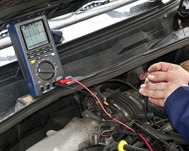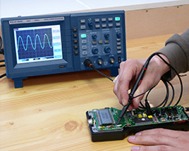



|
|
Oscilloscopes
Oscilloscopes are used by professionals in laboratory analysis or in research. Analogue
and digital oscilloscopes can be found in our shop as well as, real time oscilloscopes and with memory.
We also offer complete different versions. There are USB oscilloscopes, handheld
oscilloscopes and table oscilloscopes. They are available in the band widths of
8, 20, 25, 40, 60, 80, 100, 150 and 200 MHz. They are also equipped with two or four channels and with either a monochrome or colour display.
Most of them are equipped with a big screen to ensure highest reading ability
under all kinds of different working conditions. These oscilloscopes will offer
a product for every customer no matter what he needs it for or what he does for
a living. The features of them are widely spread and because of those many
facettes we are sure that we will be able to find the best product for you. Some models have optional software to allow for data on the display to be printed or stored data to be transferred to a
computer in order to store it for different long-term measurings or to view the
data later. All the oscilloscopes that we offer meets the IEC1010 1/CAT II safety standard. High scanning quotas are guaranteed simultaneously for all channels. Devices are ready to use (with input connectors, replacement fuse, mains cable and user's manual) straight out the box. If you can't find the oscilloscopes you are looking for, please contact us and we will help you find the best solution to suit your needs by calling our offices on: time oscilloscopes and with memory.
We also offer complete different versions. There are USB oscilloscopes, handheld
oscilloscopes and table oscilloscopes. They are available in the band widths of
8, 20, 25, 40, 60, 80, 100, 150 and 200 MHz. They are also equipped with two or four channels and with either a monochrome or colour display.
Most of them are equipped with a big screen to ensure highest reading ability
under all kinds of different working conditions. These oscilloscopes will offer
a product for every customer no matter what he needs it for or what he does for
a living. The features of them are widely spread and because of those many
facettes we are sure that we will be able to find the best product for you. Some models have optional software to allow for data on the display to be printed or stored data to be transferred to a
computer in order to store it for different long-term measurings or to view the
data later. All the oscilloscopes that we offer meets the IEC1010 1/CAT II safety standard. High scanning quotas are guaranteed simultaneously for all channels. Devices are ready to use (with input connectors, replacement fuse, mains cable and user's manual) straight out the box. If you can't find the oscilloscopes you are looking for, please contact us and we will help you find the best solution to suit your needs by calling our offices on:  UK customers +44(0) 23 809 870 30 / UK customers +44(0) 23 809 870 30 /  US customers (561) 320-9162 and our technical staff will advise you regarding our measuring instruments. Our engineers and technicians will be happy to help you with the oscilloscopes, and of course, with the other products in the field of regulation and control, and scales and balances. US customers (561) 320-9162 and our technical staff will advise you regarding our measuring instruments. Our engineers and technicians will be happy to help you with the oscilloscopes, and of course, with the other products in the field of regulation and control, and scales and balances.
Here you can see
oscilloscopes from these companies:
   
Technical specifications for Oscilloscopes can be found at the following links:
|
|
Tabletop Oscilloscopes / Oscilloscopes laboratory
|
|
- PCE-SDS
10xx Series Oscilloscopes
(Oscilloscopes
with up to 1 GS/s real-time sampling rate, 25/50 MHz bandwidth, 2 measuring
channels)
|
  |
|
- Oszilloscopes
PCE-DSO5000 Series
(Oszilloscopes
up to 200 MHz bandwidth , 1 GS/s sampling rate, High-Res 7 " TFT Display)
|
  |
|
- Oszilloscopes
PKT 1255
(Oszilloscopes with VGA-Output, big internal Memory, Bandwidth 100 MHz)
|
  |
|
- Oscilloscopes
PKT-1265
(Oscilloscopes with TFT- color display and 800 x 600 pixel, band width
30 MHz)
|
  |
|
- Oszilloscopes
PKT 1240
(Oszilloscopes with big internal Memory, Bandwidth 60 MHz and 2 Channels)
|
  |
- PCE-UT 2152C Oscilloscopes
(Handheld oscilloscopes (150 MHz), multimeters, frequency counter, USB port)
|
  |
- PKT-1200 Oscilloscopes
(Oscilloscopes with 8" colour screen, 25 MHz widthband, USB, Auto-Set function)
|
  |
- PKT-1190 Oscilloscopes
(Digital recording oscilloscopes with logic analyser up to 16 channels / 100 MHz bandwidth)
|
  |
|
- Oszilloscopes
PKT 1245
(Oszilloscopes with TFT-Colordisplay and 800 x 600 Pixel, Bandwidth 100
MHz)
|
  |
|
- PKT-1230 Oscilloscopes
(Digital recording oscilloscopes with logic analyser up to 16 channels / 200 MHz bandwidth)
|
  |
|
- Oszilloscopes
PKT-1260
(Oszilloscopes with USB for Datatransfer to PC, Bandwidth 200 MHz)
|
  |
|
PC Oscilloscopes / Oscilloscopes with USB
|
|
- PCSU1000 Oscilloscopes
(Oscilloscopes for PC, up to 50 MS/s, USB interface, spectrum analyser)
|
  |
|
Portable Oscilloscopes
|
|
- PCE-UT 81B Oscilloscopes
(Handheld oscilloscopes (8 MHz), multimeters, frequency counter, USB port / internal storage)
|
  |
|
- PCE-OC
2 Oscilloscopes
(10
MHz band width, integrated multimeter, storage for up to 100 measurements, USB
interface)
|
  |
|
- PKT-1220 Oscilloscopes
(1 channel oscilloscopes with multimeter, 20 MHz widthband, USB interface)
|
  |
|
- PKT-1205 Oscilloscopes
(Oscilloscopes with integrated multimeter, 20 MHz widthband, 2 channels, USB interface)
|
  |
|
- PKT-1195 Oscilloscopes
(Oscilloscopes with integrated multimeter, 2 channels, 100 MHz widthband, USB interface)
|
  |
|
- PCE-DSO8060 Oscilloscopes
(Handheld oscilloscopes with multimeter function, bandwidth 60 MHz, 2 channel)
|
  |
|
- DSO Scopix OX7042 Oscilloscopes
(DSO oscilloscopes with multimeter function, bandwidth 40MHz, 2 channels)
|
  |
|
- DSO Scopix OX7062 Oscilloscopes
(DSO oscilloscopes with multimeter function, bandwidth 60MHz, 2 channels)
|
  |
|
- DSO Scopix OX7102 Oscilloscopes
(DSO oscilloscopes with multimeter function, bandwidth 100MHz, 2 channels)
|
  |
|
- DSO Scopix OX7202 Oscilloscopes
(DSO oscilloscopes with multimeter function, bandwidth 200MHz, 2 channels)
|
  |
|
- DSO Scopix OX7104 Oscilloscopes
(DSO oscilloscopes with multimeter function, bandwidth 100MHz, 4 channels)
|
  |
|
- DSO Scopix OX7204 Oscilloscopes
(DSO oscilloscopes with multimeter function, bandwidth 200MHz, 4 channels)
|
  |
|
Some instruments, for example the oscilloscope PCE-UT 81B, come with an internal memory and can transmit data to and evaluate on a computer by way of an RS-232 cable. Here you can see some applications of the oscilloscopes:
|

Testing mains voltage with
PCE-UT 81B series oscilloscopes.
|

Analysing a electronic plate using
PCE-UT 2042C series oscilloscopes.
|

Case of the osciloscopes series PKT-1220
with all their delivery contents
|
Generic information about oscilloscopes: Oscilloscopes are electronic meters of graphic display showing variable electric signals over time. The vertical axis, Y, represents the voltage, while the horizontal axis, X, represents time. The images displayed on the screen are named as oscillogram. There are analog and digital oscilloscopes. However, our company offers only digital oscilloscopes. Digital oscilloscopes used a analog to digital filter (A/D) to store an analogue input signal digitally, then reconstructing this information on the screen. Digital oscilloscopes are used when you want to view and study non-repetitive periodic cycles. Digital oscilloscopes also have an additional system of data processing to store and display the signal. For slow variation signals and fast signals, digital oscilloscopes can sample at an appropriate rate to display the signal with a high resolution to then display the signal accurately on screen. The standard sampling method in digital oscilloscopes is the real time sampling: the oscilloscope collects enough points to reconstruct the signal. For non-repetitive signals or a transient part signal it is the only valid method of sampling. All our oscilloscopes are calibrated according to ISO. This allows you to have confidence in our equipment.
Relevant parameters of Oscilloscopes
Below there is a list of most important technical features of our oscilloscopes:
- Bandwidth: we specify the frequency range in which oscilloscopes can accurately measure. The bandwidth is calculated from 0Hz (DC) to the frequency at which a sinusoidal signal is displayed on a 70.7% value applied to the input.
- Time upload: this is another parameter which will give us, with the old one, the maximum frequency of use of the oscilloscope. It is an important parameter if desired to measure pulses and flanks reliably (remember that such signals have transitions between voltage levels very fast). Most oscilloscopes cannot display pulses with rise times faster than their own.
- Vertical Tenderness: indicates the oscilloscopes ease to amplify weak signals. It is usually proportional in mV per vertical division, usually is about 5mV/div (reaching up to 2 mV / div).
- Speed: for analog oscilloscopes this specification indicates the maximum speed of horizontal sweep, allowing us to observe events faster. It is usually the order of nano seconds per horizontal division.
- Speed Sampling: in digital oscilloscopes is indicated how many samples per second are able to take the data acquisition system (specifically the A / D). When oscilloscopes are quality reach sampling rates of Megasamples / sec. A large sampling rate is important when being able to see small periods of time. At the other end of the scale, low sampling rates are also needed in order to observe slowly changing signals. Generally, the sampling speed changes by acting on the Timebase command to maintain a constant number of points to be stored to represent the waveform.
- Resolution vertical: this is measured in bits and is a parameter that gives us the resolution of the A / D converter of the digital oscilloscope. It indicates with which precision input signals are converted into digital values stored in memory. Calculation techniques can increase the effective resolution of oscilloscopes.
- Record Length: tells us how many points are stored in a record for the waveform reconstruction. Some oscilloscopes allow us to vary, within certain limits, this parameter. Maximum record length depends on the size of available memory to the oscilloscopes. A large record length allows zooms on details in the waveform quickly (data have already been stored), but this advantage comes at the expense of consuming more time to sample the entire signal.
- Accuracy Gain: indicates the precision with which the vertical system of oscilloscopes attenuates or amplifies the signal. It usually provides maximum percentage of error.
- Accuracy of Time-base: indicates us accuracy in the horizontal system time base of oscilloscopes to display the time. Also often these give the percentage of maximum error.
If you wish to view or print a selection of oscilloscopes from our catalogue, click the PDF symbol.

|





























